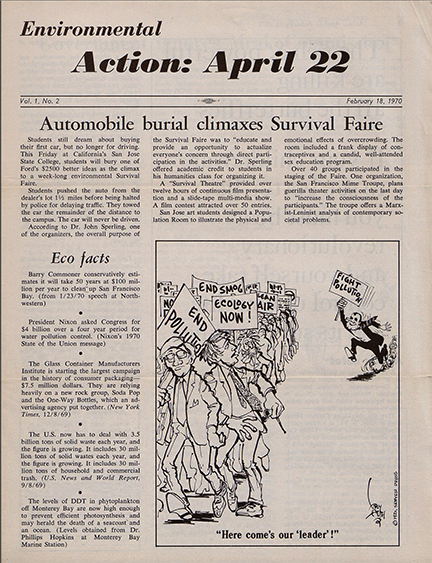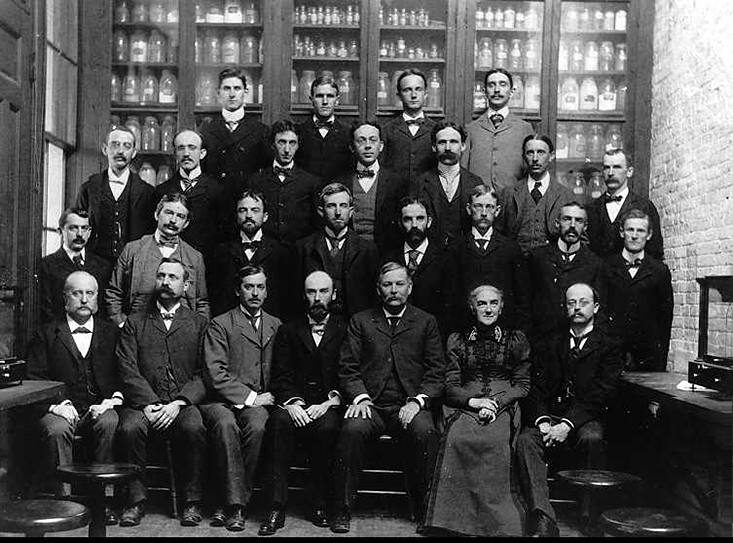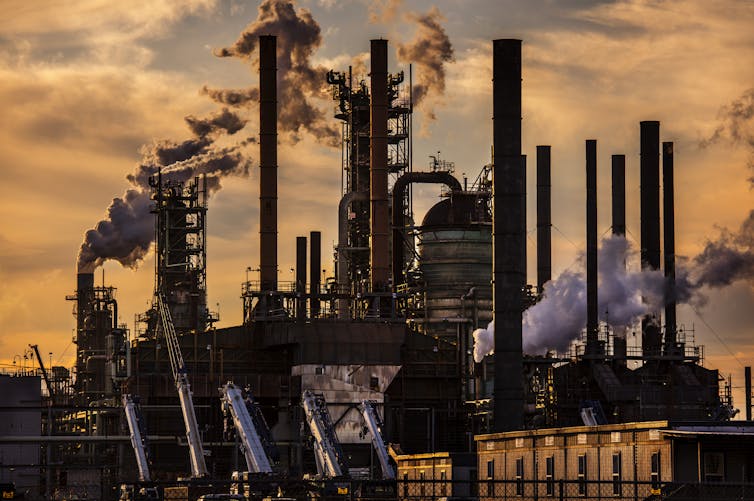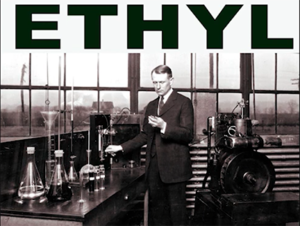EH in the News
 Environmental Action Archive
Environmental Action Archive
starting with Earth Day 1970 is now open at the University of Pittsburgh. Ellen Swallow Richards is profiled in March, 2017 Nautilus Magazine as "the woman who gave us the science of normal life." Richards first became active in environmental issues in the 1870s and was an important early voice in the Progressive reform movement at the turn of the 20th century.
Ellen Swallow Richards is profiled in March, 2017 Nautilus Magazine as "the woman who gave us the science of normal life." Richards first became active in environmental issues in the 1870s and was an important early voice in the Progressive reform movement at the turn of the 20th century.  The hats that created bird sanctuaries like the Mahleur Wildlife Preserve in Oregon in 1908 are featured in this OPB web site. The Mahleur has been the scene of a confrontation between right wingers and the federal government in January 2016.
The hats that created bird sanctuaries like the Mahleur Wildlife Preserve in Oregon in 1908 are featured in this OPB web site. The Mahleur has been the scene of a confrontation between right wingers and the federal government in January 2016.  Pollution regs saved lives says Michael Greenstone in this Sept. 24, 2015 article in the New York Times. Although some people want to repeal the Clean Air Act, air quality regulations have averted tens of thousands of premature deaths, Greenstone says.
Pollution regs saved lives says Michael Greenstone in this Sept. 24, 2015 article in the New York Times. Although some people want to repeal the Clean Air Act, air quality regulations have averted tens of thousands of premature deaths, Greenstone says.  LA's first big smog on July 26, 1943 is the subject of this Wired article. Of course, there had been many previous smog incidents, but mostly involving coal in Europe and the industrialized eastern US. As Peter Dykstra notes on the radio program Living on Earth, it was the first smog caused by automobiles.
LA's first big smog on July 26, 1943 is the subject of this Wired article. Of course, there had been many previous smog incidents, but mostly involving coal in Europe and the industrialized eastern US. As Peter Dykstra notes on the radio program Living on Earth, it was the first smog caused by automobiles.  ¶ A giant tree's death sparked the conservation movement in 1853. Terrific article by Leo Hickman of the Guardian on June 27, 2013. The "Mother of the Forest" was also covered in Neuzil and Kovarik's Mass Media and Environmental Conflict published in 1996.
¶ A giant tree's death sparked the conservation movement in 1853. Terrific article by Leo Hickman of the Guardian on June 27, 2013. The "Mother of the Forest" was also covered in Neuzil and Kovarik's Mass Media and Environmental Conflict published in 1996.  ¶ Dymaxion car Blueprints for the 1933 Dymaxion car designed by Buckminster Fuller showed up in a Massachusetts recently. The car was far ahead of its time but a fatal accident on a test site stalled development.
¶ Dymaxion car Blueprints for the 1933 Dymaxion car designed by Buckminster Fuller showed up in a Massachusetts recently. The car was far ahead of its time but a fatal accident on a test site stalled development. ¶ 1970 Clean Car Race is reported in MIT Technology Review in August, 2013. The cleanest car, among the electrics and hybrids, was a modified internal combustion engine.
¶ Buffalo soldiers In the late 19th century and early 20th century, black cavalry troopers patrolled Yosemite and Sequoia national parks in California. A new book describes their role. (Chicago Tribune, June 18, 2013).
¶
What ever happened to the environmental movement? asks the New Yorker in this flawed but interesting April 12, 2013 article by Nicholas Lemann. Also noteworthy is this response by Jason Mark of Earth Island Journal.
¶ DDT history exhibit scheduled for Midlands, Mich. college, April 2013.

¶ London smog has been infamous for centuries, but when 4,000 people died in 1952, the British government finally started to act. Telegraph, Dec. 6, 2012. China's news agency, Xinhau, noted in an article Feb. 25, 2013, that London's historical experience could provide a lesson for Beijing about how to deal with an air pollution crisis.¶ History of the Commons and today's environmental crisis is an excellent read in the May/June 2013 Utne Magazine.
¶ Saving the NJ Pine Barrens Writer John McPhee recalls the struggle to save a remnant of wilderness on the east coast. Philadelphia Inquirer, March 4, 2013.
 ¶ Aldo Leopold is remembered by the editor of the Milwaukee Journal, March 2, 2013. The forester and conservationist articulated a "land ethic" in his 1949 book A Sand County Almanac.
¶ Aldo Leopold is remembered by the editor of the Milwaukee Journal, March 2, 2013. The forester and conservationist articulated a "land ethic" in his 1949 book A Sand County Almanac. ¶ Remembering Darwin Scientific American remembers Charles Darwin and his impact on science on the 204th anniversary of his birthday, Feb. 12, 2012.
¶ Shackleton crew's 1916 ordeal -- a perilous journey taken after their ship got stuck and sank in Antarctica -- is being reinacted by a group of British and Australian adventurers. (Associated Press, Feb. 10, 2013)
¶ US air pollution was a lot like the pollution now in Beijing says Jim Bruggers of the Louisville Courier Journal and Alexis Madrigal in the Atlantic magazine in January 2013 articles. KCET public television also had a well illustrated article on L.A.'s smoggy past.
¶ First subway The London tube is 150 years old on Jan. 9, 2013. Mind the gap!
¶ Birth of the Clean Water Act Living on Earth interviews William Ruckelshaus, the first EPA administrator, about the Clean Water Act of 1972. "it was a terrible time," Ruckelshaus said. "I remember the first time I moved to Washington and the air was brown as I’d go to work in the morning. There was no industry in Washington at the time, that was all automobile pollution." Dec. 28, 2012.
¶ Remembering Barry Commoner A biologist and activist best known for studying baby’s teeth to demonstrate that radioactive fallout from atomic weapons testing was getting into our food supply and endangering our health. Living on Earth, Oct. 5, 2012.
¶ Bodega nuclear fight Gary Pace of Sebastopol, California reflects on the 1960s fight over building a nuclear power plant on top of the San Andreas earthquake fault at the Bodega Headlands. "I often wonder how (environmentalists) found the outrageous hope that they could halt the building of a nuclear plant once the work had started and I ask for similar inspiration." Living on Earth, Sept. 28, 2012.
¶ Climate change drove early human migration, anthropologists believe. NPR, Sept. 20, 2012.
¶ Ancient deforestation created the Danube River delta 8,000 years ago, scientists have found. Sept. 14, 2012New York Times.
¶ Environmental injustice The Hawks Nest Disaster of 1930 - 33 is getting a new memorial. In the infamous incident, between 700 to 3,000 US workers were killed or severely injured for life after boring a tunnel through a section of pure silica without then-standard respiratory protection. Sept. 7, 2012, W.V. Gazette. Also see this People's Press 1935 article about the disaster.
¶ National mammal? Teddy Roosevelt V argues that the US should remember its conservation history by making the bison the country's national mammal. Sept. 4, 2012
¶ Environmental Future Postcards from the past show the world of the future in 2012 in all its dazzling glory, from air police stopping traffic to whales pulling carriages full of divers. Fast Company, Aug. 20, 2012

¶ Smog of History LA Times recaps an article about testing pollution control devices in the 1950s. Aug. 17, 2012¶ Remembering the Radium Craze France's 19th century radium craze still haunts Paris, Reuters reports. "When the Franco-Polish Nobel Prize winner Marie Curie discovered the radioactive element radium in 1898, she set off a craze for the luminescent metal among Parisians, who started using it for everything from alarm clock dials to lipsticks and even water fountains." July 20, 2012
¶ Drought in ancient times The ancient Mayan water system was designed with drought in mind, as this New York Times article notes. Are there lessons for the modern era? July 17, 2012.
Author Archives: Bill Kovarik
Leaded gasoline centennial interdisciplinary zoom panel Dec. 9, 2021
Comments Off on Leaded gasoline centennial interdisciplinary zoom panel Dec. 9, 2021
Posted in Environmental justice, Technology & environment
A century of tragedy: Leaded gasoline
By Bill Kovarik
From The Conversation, Dec. 9, 2021
 On the frosty morning of Dec. 9, 1921, in Dayton, Ohio, researchers at a General Motors lab poured a new fuel blend into one of their test engines. Immediately, the engine began running more quietly and putting out more power.
On the frosty morning of Dec. 9, 1921, in Dayton, Ohio, researchers at a General Motors lab poured a new fuel blend into one of their test engines. Immediately, the engine began running more quietly and putting out more power.
The new fuel was tetraethyl lead. With vast profits in sight – and very few public health regulations at the time – General Motors Co. rushed gasoline diluted with tetraethyl lead to market despite the known health risks of lead. They named it “Ethyl” gas.
It has been 100 years since that pivotal day in the development of leaded gasoline. As a historian of media and the environment, I see this anniversary as a time to reflect on the role of public health advocates and environmental journalists in preventing profit-driven tragedy.
Lead and death
By the early 1920s, the hazards of lead were well known – even Charles Dickens and Benjamin Franklin had written about the dangers of lead poisoning.
When GM began selling leaded gasoline, public health experts questioned its decision. One called lead a serious menace to public health, and another called concentrated tetraethyl lead a “malicious and creeping” poison.
Comments Off on A century of tragedy: Leaded gasoline
Posted in Uncategorized
A brief history of gasoline
 Lies about climate change are only part of the environmental history problem posed by the way that the oil and auto industries told their stories in books, museum or bus caravans (like the one above.) A full ‘warts and all’ history is still only barely known. Jamie Kitman, automotive writer and attorney, created this series for Jalopnik Magazine.
Lies about climate change are only part of the environmental history problem posed by the way that the oil and auto industries told their stories in books, museum or bus caravans (like the one above.) A full ‘warts and all’ history is still only barely known. Jamie Kitman, automotive writer and attorney, created this series for Jalopnik Magazine.
- Part I: A Brief History of Gasoline: A century and a half of lies In which the author describes youthful misconceptions about gasoline of the leaded and unleaded variety.
- Part II: A Brief History Of Gasoline: They Trashed Pennsylvania First — The long and oily road, or everything you need to know you can learn from Pennsylvania
- Part III: How gasoline got into our lives describes the early history of Standard Oil Co.
- Part IV: How Standard Oil built its toxic monopoly Standard gave the government every piece of evidence on how corporations lie, cheat, and poison the country.
- Part V: How Standard Oil got away with it We bust the trust here, we sue Exxon there, yet the money keeps raking in, and the pollution keeps seeping out.
- Part VI: Better things through deader living: How does a company grow so callous, so numb to and invested in death that it puts lead in gasoline?
- Part VII: The Original Sin of General Motors GM was not dreamed up like other car companies. It wanted monopoly.
- Part VIII: Searching for the magic bullet: Leaded gasoline and General Motors.
Comments Off on A brief history of gasoline
Posted in Fossil fuels, Technology & environment
How big oil knew about climate change

The oil industry was aware of the risks of climate change decades ago.
By Benjamin Franta, Stanford University
Four years ago, I traveled around America, visiting historical archives. I was looking for documents that might reveal the hidden history of climate change – and in particular, when the major coal, oil and gas companies became aware of the problem, and what they knew about it.
I pored over boxes of papers, thousands of pages. I began to recognize typewriter fonts from the 1960s and ‘70s and marveled at the legibility of past penmanship, and got used to squinting when it wasn’t so clear.
What those papers revealed is now changing our understanding of how climate change became a crisis. The industry’s own words, as my research found, show companies knew about the risk long before most of the rest of the world.
On Oct. 28, 2021, a Congressional subcommittee questioned executives from Exxon, BP, Chevron, Shell and the American Petroleum Institute about industry efforts to downplay the role of fossil fuels in climate change. Exxon CEO Darren Woods told lawmakers that his company’s public statements “are and have always been truthful” and that the company “does not spread disinformation regarding climate change.”
Here’s what corporate documents from the past six decades show.
Surprising discoveries
At an old gunpowder factory in Delaware – now a museum and archive – I found a transcript of a petroleum conference from 1959 called the “Energy and Man” symposium, held at Columbia University in New York. As I flipped through, I saw a speech from a famous scientist, Edward Teller (who helped invent the hydrogen bomb), warning the industry executives and others assembled of global warming.
Comments Off on How big oil knew about climate change
Posted in Climate, Fossil fuels
Is 45% solar by 2050 feasible?
Research Associate, University of Texas at Austin
For The Conversation
As President Joe Biden called for major clean energy investments as a way to curb climate change and generate jobs on Sept. 8, 2021, the White House released a report produced by the U.S. Department of Energy that found that solar power could generate up to 45% of the U.S. electricity supply by 2050, compared to less than 4% today. Joshua D. Rhodes, an energy technology and policy researcher at the University of Texas at Austin, weighed in on aspects of the plan for The Conversation.
Why such a heavy focus on solar power? Doesn’t a low-carbon future require many types of clean energy?
The Energy Department’s Solar Futures Study lays out three future pathways for the U.S. grid: business as usual; decarbonization, meaning a massive shift to low-carbon and carbon-free energy sources; and decarbonization with economy-wide electrification of activities that are powered now by fossil fuels.
It concludes that the latter two scenarios would require approximately 1,050-1,570 gigawatts of solar power, which would meet about 44%-45% of expected electricity demand in 2050. For perspective, one gigawatt of generating capacity is equivalent to about 3.1 million solar panels or 364 large-scale wind turbines.
The rest would come mostly from a mix of other low- or zero-carbon sources, including wind, nuclear, hydropower, biopower, geothermal and combustion turbines run on zero-carbon synthetic fuels such as hydrogen. Energy storage capacity – systems such as large installations of high-capacity batteries – would also expand at roughly the same rate as solar.
One advantage solar power has over many other low-carbon technologies is that most of the U.S. has lots of sunshine. Wind, hydropower and geothermal resources aren’t so evenly distributed: There are large zones where these resources are poor or nonexistent.
Comments Off on Is 45% solar by 2050 feasible?
Posted in Renewable energy, Technology & environment
IPCC: Code Red on Climate Change
Reuters: “HUMANS ARE TO BLAME – FULL STOP The Intergovernmental Panel on Climate Change (IPCC) used its strongest terms yet to assert that humans are causing climate change, with the first line of its report summary reading: “It is unequivocal that human influence has warmed the atmosphere, ocean and land.”
Associated Press; ‘Earth’s climate is getting so hot that temperatures in about a decade will probably blow past a level of warming that world leaders have sought to prevent, according to a report released Monday that the United Nations called a “code red for humanity.” “It’s just guaranteed that it’s going to get worse,” said report co-author Linda Mearns, a senior climate scientist at the U.S. National Center for Atmospheric Research. “Nowhere to run, nowhere to hide.
UN-IPCC: GENEVA, Aug 9, 2021 – Scientists are observing changes in the Earth’s climate in every region and across the whole climate system, according to the latest Intergovernmental Panel on Climate Change (IPCC) Report, released today. Many of the changes observed in the climate are unprecedented in thousands, if not hundreds of thousands of years, and some of the changes already set in motion—such as continued sea level rise—are irreversible over hundreds to thousands of years. However, strong and sustained reductions in emissions of carbon dioxide (CO2) and other greenhouse gases would limit climate change. While benefits for air quality would come quickly, it could take 20-30 years to see global temperatures stabilize, according to the IPCC Working Group I report, Climate Change 2021: the Physical Science Basis, approved on Friday by 195 member governments of the IPCC, through a virtual approval session that was held over two weeks starting on July 26.
Comments Off on IPCC: Code Red on Climate Change
Posted in Climate
Wishing you were here, Berta Cáceres
Roger Waters, a member of Pink Floyd, sings “Wish you were here” for Berta Cáceres.
Comments Off on Wishing you were here, Berta Cáceres
Posted in Art & environment, Environmental justice
Assassin convicted in Honduras
TEGUCIGALPA, Honduras (AP) — July 6, 2021 — A Honduran man was convicted of homicide in the 2016 killing of Berta Cáceres, a prize-winning environmental and Indigenous rights defender.
After a three-month trial, the court unanimously found Roberto David Castillo Mejía guilty of participating in the killing of Cáceres, a member of the Lenca Indigenous group who led opposition to a dam project in which Castillo Mejía was involved. MORE
Comments Off on Assassin convicted in Honduras
Posted in Environmental justice
Environmental activists are being killed in Honduras over their opposition to mining
University of Western Ontario
The Conversation, May 6, 2021
Two men shot Arnold Joaquín Morazán Erazo to death in his home in Tocoa, Honduras, one night in October 2020.
 Morazán was an environmental activist and one of 32 people criminalized by the Honduran government for defending the Guapinol River against the environmental impacts of a new iron oxide mine in the Carlos Escaleras National Park.
Morazán was an environmental activist and one of 32 people criminalized by the Honduran government for defending the Guapinol River against the environmental impacts of a new iron oxide mine in the Carlos Escaleras National Park.
So far, at least eight people who have opposed the mine have been killed, putting its owner, Inversiones Los Pinares, at the centre of a deadly environmental conflict in the mineral-rich Bajo Aguán region. Local communities are concerned about the mine’s potential ecological damage. In their attempts to defend their territories, local leaders have been surveilled, threatened, injured and imprisoned, and some, like Morazán, have been killed.
Honduras is the deadliest place in the world for environmental defenders. Hundreds of them have been killed since 2009, including the Indigenous environmental leader Berta Càceres, who was assassinated in 2016.
The details are murky for some of the killings. In 2019, as a member of a fact-finding delegation, my colleagues and I documented that national police and military forces have patrolled the territory surrounding the mining project. We have recommended a thorough, prompt and impartial investigation of the human rights abuses by military police and paramilitary forces against human rights defenders and journalists in Tocoa. Continue reading
Comments Off on Environmental activists are being killed in Honduras over their opposition to mining
Posted in Environmental justice
Minamata film explores a key moment in environmental history
One of the great turning points in environmental history –a “Silent Spring” moment — involved the environmental catastrophe in Minamata, Japan that started in the 1950s but shocked. the world in 1971.
Fifteen years into the catastrophe, the now-famous photos from Minamata re-aligned perceptions of how dangerous chemicals can have devastating effects on human health. No one could look at the photos of Tomoko Uemura and doubt that.
The story behind the Minamata photos, and the price that American photographer W. Eugene Smith paid for taking them, is the subject of a new film (released Feb. 2021) starring Johnny Depp, Hiroyuki Sanada, Jun Kunimura, Ryo Kase, Tadanobu Asano and Bill Nighy.
It’s not a well known story, possibly because Smith was one of the most exasperating artists who ever picked up a camera. In fact, a PBS documentary about his life was entitled “Photography Made Difficult.”
Comments Off on Minamata film explores a key moment in environmental history
Posted in Art & environment, Environmental justice, Humanities & environmental history



 William Bartram,
William Bartram, 